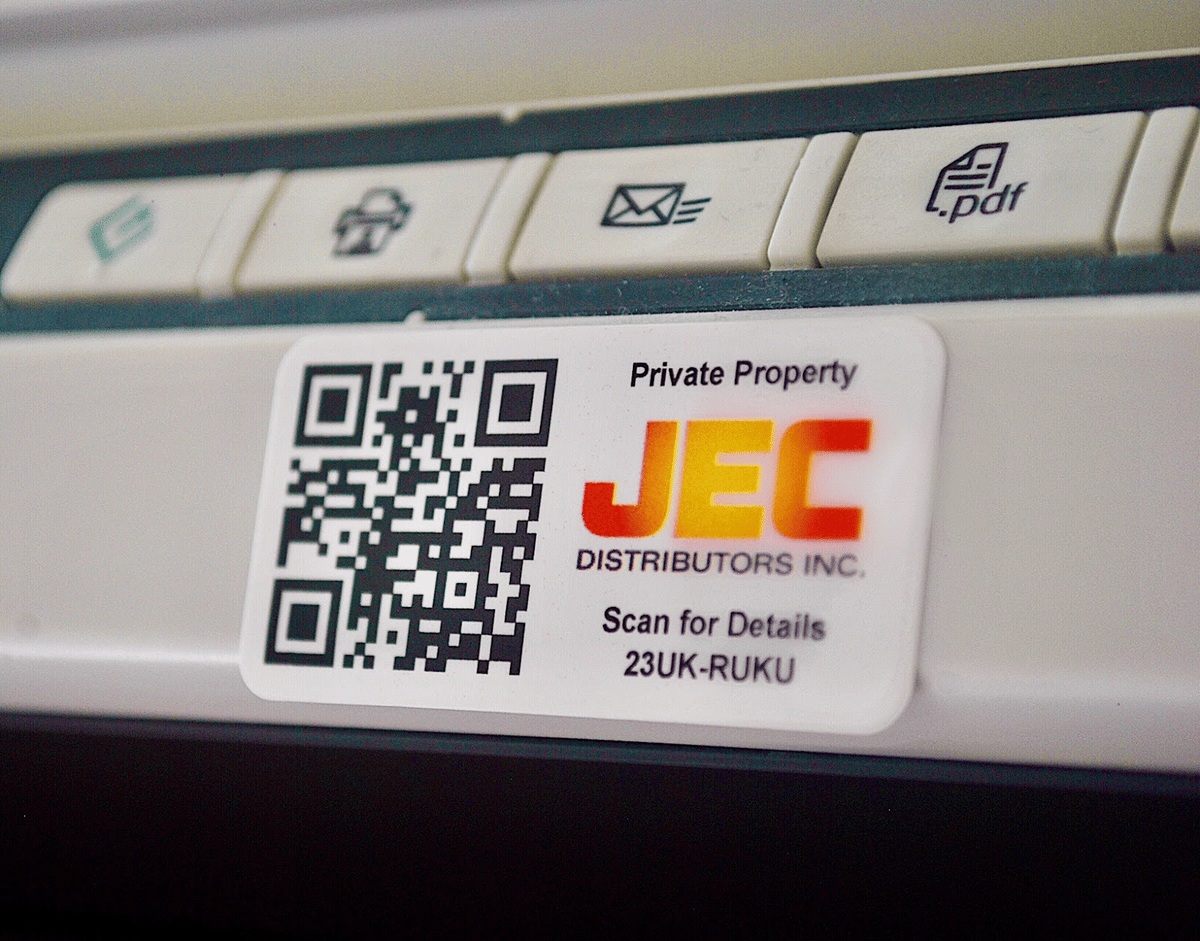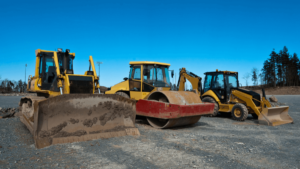Taking proper care of your equipment is an important aspect of success in the construction industry, and it starts with effective tracking.
In the beginning, you may be able to keep track of all of your assets’ location and condition manually.
However, as your business grows over time, your inventory will expand, and using an asset tag system will become indispensable for an effective workflow.
If you want to find out more about what construction tags are, how to apply them on equipment and how they can serve your business, read on.
In this article...
What Are Construction Tags
Construction tags are labels that contain information about the object they are attached to. You can put them on construction tools, equipment, vehicles or any other asset in your inventory.
Asset tags hold the identifying details of an item, like the manufacturing date, original price, where it was bought, which worker used it last, etc.
Those are practical for manual inventory checks and often come in the form of a barcode or a QR code, which can look something like this:

In order to extract the data, all you have to do is scan the code, and the information will pop up on your screen.
Asset tags can also provide information on the location and condition of a piece of equipment, which is crucial for equipment tracking or general asset management.
In this case, you need to connect construction tags with equipment-tracking software.
The software provides you with an interface where you can access all of your assets’ information.
From there, you can track your equipment’s location, check maintenance schedules, carry out audits, and perform other important asset management tasks.
What Are Construction Tags Used For
Construction tags come in various shapes and sizes, and can be utilized for different purposes.
If all that you need is an easier method for identifying your assets, it’s often a good idea to go with the cheaper, smaller, easily scannable tags.
For more complex tasks, you might consider investing in a GPS or RFID tag system.
Big construction companies with a diverse collection of assets might benefit from a combination of tags.
For example, barcodes for office equipment, QR codes for tools, and GPS tags for machinery.
Below are some of the most common ways you can use construction tags for your business.
Tracking Construction Equipment
Working on construction sites involves a large number of movable assets of various sizes.
For instance, there are many different kinds of tools that are relatively small and used by multiple workers, which means they could easily get misplaced or lost.
On the other hand, valuable vehicles are often left on-site during the night. This can make them an easy target for criminals.
In 2021, there was a report of a man stealing a $165,000 caterpillar loader from a construction site, to which he drove with another piece of equipment stolen from a different site.
This story alone should show you how unprotected construction sites can sometimes be.
Equipment tracking allows you to oversee the location of your construction equipment so it can be retrieved even if it gets lost or stolen.
GPS tags are especially useful as a theft prevention method.
After all, criminals want to get away with their crime, and if they see a tag and know that equipment is being tracked, they are more likely to think twice before trying to steal it.
Conducting Equipment Audits
Construction tags can also be used to conduct more efficient equipment audits.
Regular audits are important for any company that bases its business model on working with physical assets.
To avoid unnecessary financial losses, you need to verify that all of your equipment is present and in working condition.
However, having your employees manually check every item against a long list full of serial numbers is an error-prone process.
To make it worse, it takes a lot of time and energy to complete.
Asset tags make the procedure much quicker and easier to perform.
Your workers can simply scan the code with a scanner or a smartphone, which automatically transmits and saves the information into the central database.

From the software interface, you can make custom groupings and lists of your equipment depending on the goal of the audit.
Monitoring Maintenance Schedules
Construction tags usually contain information that is useful for monitoring maintenance schedules.
Scanning the code reveals how old an item is, when it was last repaired, and how long until its next scheduled maintenance appointment.
Every time you update an entry with new details, you add a new layer of data which you can use for more accurate analysis and responsive decision-making.
This process is ideal for equipment that needs proactive maintenance. In other words, for assets that you can’t afford to malfunction during work hours.
With a tracking software solution, you can follow their condition over different periods and come up with maintenance dates accordingly.
The system will send a notification every time a scheduled date is coming up, which will allow you to properly organize and prepare.
How to Tag Construction Equipment
Now you know the benefits of tagging your equipment, you’re probably thinking about the many ways it can advance your company’s workflow.
But before you start to build the system, you need to lay the groundwork.
First, you must choose a tag or a combination of tags that will be the best fit for your business.
After the purchase, you need to connect the tags to the software database, imbued with the relevant information about the asset.
The tags are then applied to their designated object and you’re good to go.
Below are a few more details about each step to help you along.
Choose the Right Type of Construction Tag
The first step towards making construction tags work is choosing which ones are the right option for you.
There are a few main categories of asset tags.
To decide which one you want, you should consider what purpose you need them for, the type and scope of your equipment, and the size of your budget.
Barcodes are square labels made up of black lines and numbers on a white background. They hold the least amount of data, but are very cheap and easy to use.
QR codes are an advanced version of a barcode. They are similar in size and application, but QR tags have more space and support multiple file types.
Also, they are more durable and can be scanned from a greater distance.
If you own equipment that needs location tracking, you might want to research RFID tags.
For this system to work, you will need to get an antenna, RFID readers, and tags with a processing unit. This makes them more expensive and less compact.
However, RFID tags can be activated from a distance of up to 150 meters and radio waves are not obstructed by walls, which is handy for tracking movable assets.
BLE tags appeared on the market relatively recently. Based on their functionality, they can be regarded as the successor to RFID.
Their signals travel a comparable length, and they both require power to work.
Where BLE tags excel beyond RFID is their exceedingly long-lasting battery, compact size, and affordability.
GPS technology also involves sending and receiving wireless signals, but instead of using antennas, it does it via satellites.
It is worth investing in if your company works on multiple sites, or on a national or international level.
Record and Connect the Equipment’s Information
In order to use construction tags effectively, you first need to record and connect your equipment’s information to the asset tracking software.
This way, when an employee scans a tag, they can see all the information the system has stored in relation to that piece of equipment.
At the same time, scanning updates the asset’s database entry with a new data point.
There are no rules about which details a construction tag should hold.
However, it’s usually the asset’s serial or model number, where it was manufactured or sold, the date and price of purchase, and its location and condition.
It is recommended that you also assign a unique serial number to each piece of equipment, so you can track them individually.
A company called Safety Nets NZ even released an article showcasing the benefits of this approach.
To stay compliant and continue providing safe service, they have to test every one of their 10,000 nets on an annual basis.
Without unique ID numbers, it would be extremely challenging to keep track of which nets require testing and when.
Apply the Construction Tag
The final step in the tagging process is applying construction tags to the equipment.
The type of application will again depend on your assets and work environment.
Pressure-sensitive adhesive tags are easy to apply, but they are sensitive to heat and humidity. They are most suitable for indoor work.
Even so, some are more durable than others, like for example polyester tags:

Tags that need mechanical application, like engraved plates, are much more resistant and used for vehicles, machines and other equipment that is mostly kept outdoors.
Of course, they will cost you more.
Regardless of the method you choose, make sure that the tags are placed in an area where they are the least likely to be damaged or exposed to dirt, heat, grease or grime.
This will improve the longevity of your construction tags, which will save you time on replacements and reduce operational cost.
Conclusion
Construction tags are an essential tool for building an efficient asset management structure for your company.
You can use them for various purposes, like equipment tracking, keeping up with maintenance dates, and faster and more precise asset audits.
Setting them up is simple.
You first need to choose an appropriate tag type.
Construction tags are then connected with a designated equipment tracking software which also serves as a database with your equipment’s information.
Lastly, tags need to be affixed to your assets.
And that’s it! You are now ready to start using construction tags and help your business grow.









